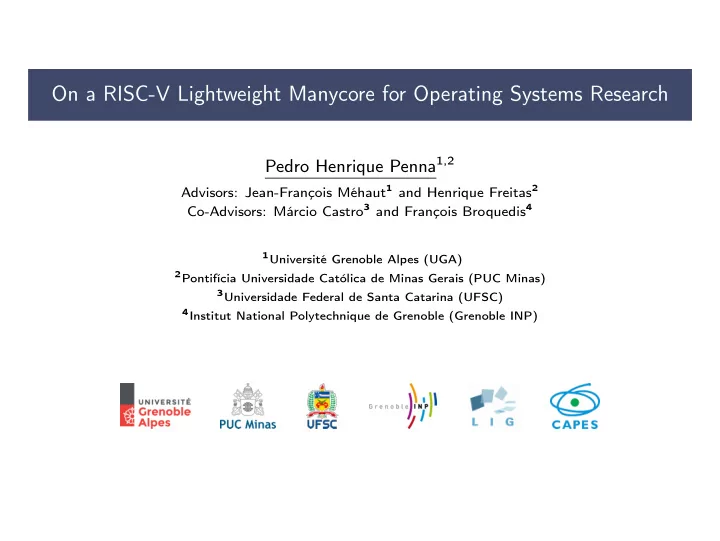

On a RISC-V Lightweight Manycore for Operating Systems Research Pedro Henrique Penna 1,2 Advisors: Jean-François Méhaut 1 and Henrique Freitas 2 Co-Advisors: Márcio Castro 3 and François Broquedis 4 1 Université Grenoble Alpes (UGA) 2 Pontifícia Universidade Católica de Minas Gerais (PUC Minas) 3 Universidade Federal de Santa Catarina (UFSC) 4 Institut National Polytechnique de Grenoble (Grenoble INP)
Lightweight Manycores Architectural Features Thousands of Lightweight Cores Devices I/O Cluster DRAM MIMD workloads core core core Massive thread-level parallelism SRAM Low power consumption NoC DMA NoC Distributed Memory Architecture Performance scalability Communication predictability core core NoC On-Chip Heterogeneity SRAM Adaptability to computing demands core core DMA High energy efficiency Compute Cluster Rich On-Chip Interconnects Figure: LW manycore with 67 cores. Quality of Service (QoS) Asynchronous communications Currently used in embedded computing, critical systems and networking What about domains with multi-application requirements? Pedro Henrique Penna Nanvix: An OS for LW Manycores 1 / 10
Lightweight Manycores Software Challenges High Density Circuit Integration Devices I/O Cluster DRAM Heat dissipation core core core Dark silicon SRAM Distributed Memory Architecture NoC DMA NoC Small local memories Challenging software design core core NoC On-Chip Heterogeneity SRAM Thread scheduling core core DMA Data placement Compute Cluster Rich On-Chip Interconnects Figure: LW manycore with 67 cores. Network congestion Security checking Performance vs Programmability vs Portability Pedro Henrique Penna Nanvix: An OS for LW Manycores 2 / 10
Operating Systems for Lightweight Manycores Why bother? An Operating System (OS) Bridges Software Challenges Expose rich abstractions and APIs Multiplex access to resources Provide and ensure security How about Using Commodity Kernels? Ex: Linux, FreeBSD, Windows... Pros: automatically support tons of software Cons: memory footprint is too large to fit in lightweight manycores Is It Possible to Design OSes for LW Manycores Like We Do for Multicores? Symmetric kernel design leads to cache interference (Wentzlaff and Agarwal 2009) Poor fine-grain lock scalability (Amdahl’s Law) Increasingly diverse hardware (Baumann et al. 2009) Multiple non-coherent physical address spaces (Dinechin et al. 2013) No, we need another approach! Pedro Henrique Penna Nanvix: An OS for LW Manycores 3 / 10
Operating Systems for Lightweight Manycores The Multikernel Design Kernels Run (self-consciously) on each cluster Provide minimum abstractions Ensure policies and security Idle Core System Servers Kernel Core Run on top of kernels at user-level Service Core Provide traditional abstractions Application A Collaboratively implement subsystems Application B Runtime Libraries Run alongside with user-applications Figure: The multikernel OS structure. Interface with system servers Expose standard APIs (i.e., POSIX) The Nanvix Operating System Joint research between UGA, PUC Minas, UFSC and Grenoble INP Multikernel designed from scratch to lightweight manycores Supports multiple ISAs: RISC-V, OpenRISC, x86 and Bostan (Kalray MPPA-256) https://github.com/nanvix Pedro Henrique Penna Nanvix: An OS for LW Manycores 4 / 10
Operating Systems for Lightweight Manycores The Multikernel Design - Architectural Requirements Two-Level Privilege Mode Resource protection Bare-bones for security Virtual Memory Support Physical memory multiplexing Address space expansion and protection Must have to provide process abstraction Atomic Instructions Intra-cluster thread synchronization Required in multicore clusters Fast Interrupt/Exception Forwarding User-Level interrupt/exception handling Essential for fast microkernel support Fine-Grain Interrupt Hooking Control Interrupt priority scheme Low-latency in inter-cluster communication Pedro Henrique Penna Nanvix: An OS for LW Manycores 5 / 10
RISC-V Based Manycores Why RISC-V? Three-Level Privilege Mode (Machine, Supervisor and User) 48-bit Address Space Support Atomic Instructions Interrupt/Exception Delegation Flexible and Extensible ISA Rich Interrupt System Multiple open-source implementations Trending architecture and active community Pedro Henrique Penna Nanvix: An OS for LW Manycores 6 / 10
RISC-V Based Manycores Virtual Platforms Gem5 Full architectural simulation Too slow for system design and development Partial support for RISC-V Time-consuming and hard to change QEMU Fast processor emulation Rich system debugging support Adequate for medium-size configurations Support for RV32GC, RV64GC, Spike and SiFive Misses distributed configuration model Pedro Henrique Penna Nanvix: An OS for LW Manycores 7 / 10
RISC-V Based Manycores FPGA Emulation: bigPULP PULP Cluster 1+8 RI5CY cores 4 KB of L1 I-Cache 256 KB of L1 SPM 256 KB of L2 SPM DMA controller RI5CY Core Low energy consumption 4-stage 32-bit pipeline I M F C extensions Figure: bigPULP architecture overview. Partial M and U modes No virtual memory No atomic instructions Pedro Henrique Penna Nanvix: An OS for LW Manycores 8 / 10
RISC-V Based Manycores FPGA Emulation: OpenPiton+Ariane OpenPiton Tiled Configuration Mesh NoC topology Cache-coherence system Directory coherence Ariane Core High performance 6-stage 64-bit pipeline I M A C extensions M, S and U modes Remote GDB support Figure: OpenPiton+Ariane architecture overview. Design is to large to emulate a manycore configuration 2x2 single hart system in Xilinx VC707 ($ 3,495) Pedro Henrique Penna Nanvix: An OS for LW Manycores 9 / 10
Conclusions Recap Lightweight Manycores Distributed memory configuration Rich on-chip interconnect Operating System for Lightweight Manycores Enable multi-applications to be deployed alongside Expose rich abstractions and APIs Multiplex hardware resources fairly and safely What Is next? Virtual RISC-V Manycore Platform QEMU-based platform emulation Virtual interconnect with network interfaces Patch RISC-V platforms with network devices RISC-V Manycore FPGA Emulation Configuration on OpenPiton+Ariane Lighter Ariane cores (remove hardware PTW, branch prediction, cache system) Pedro Henrique Penna Nanvix: An OS for LW Manycores 10 / 10
Recommend
More recommend